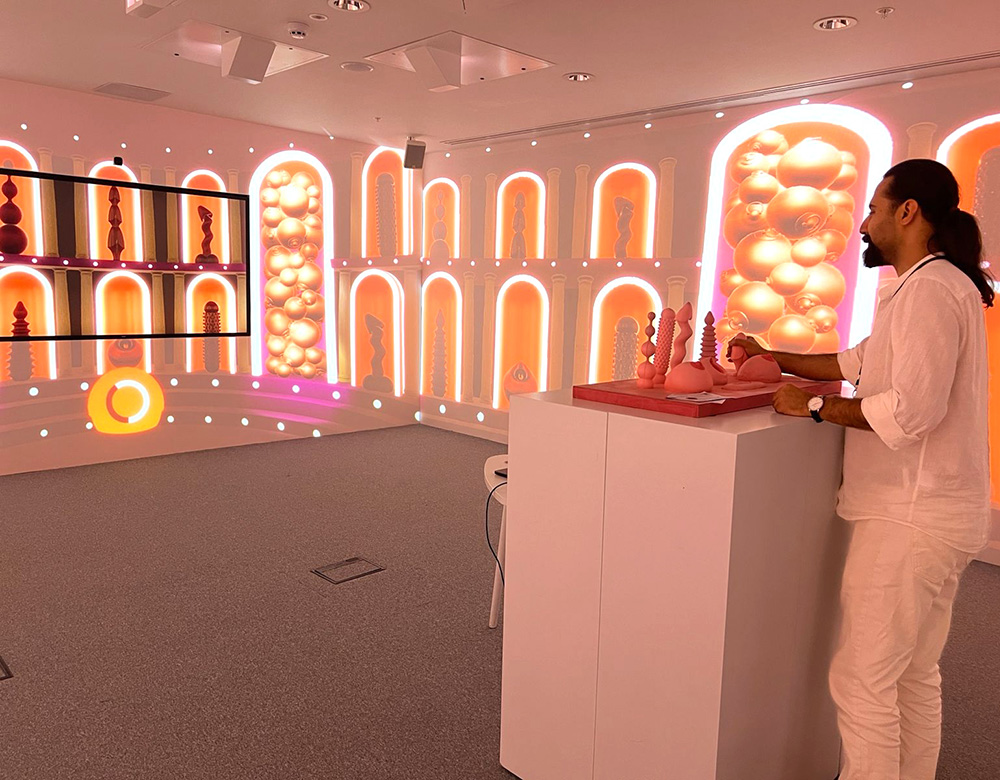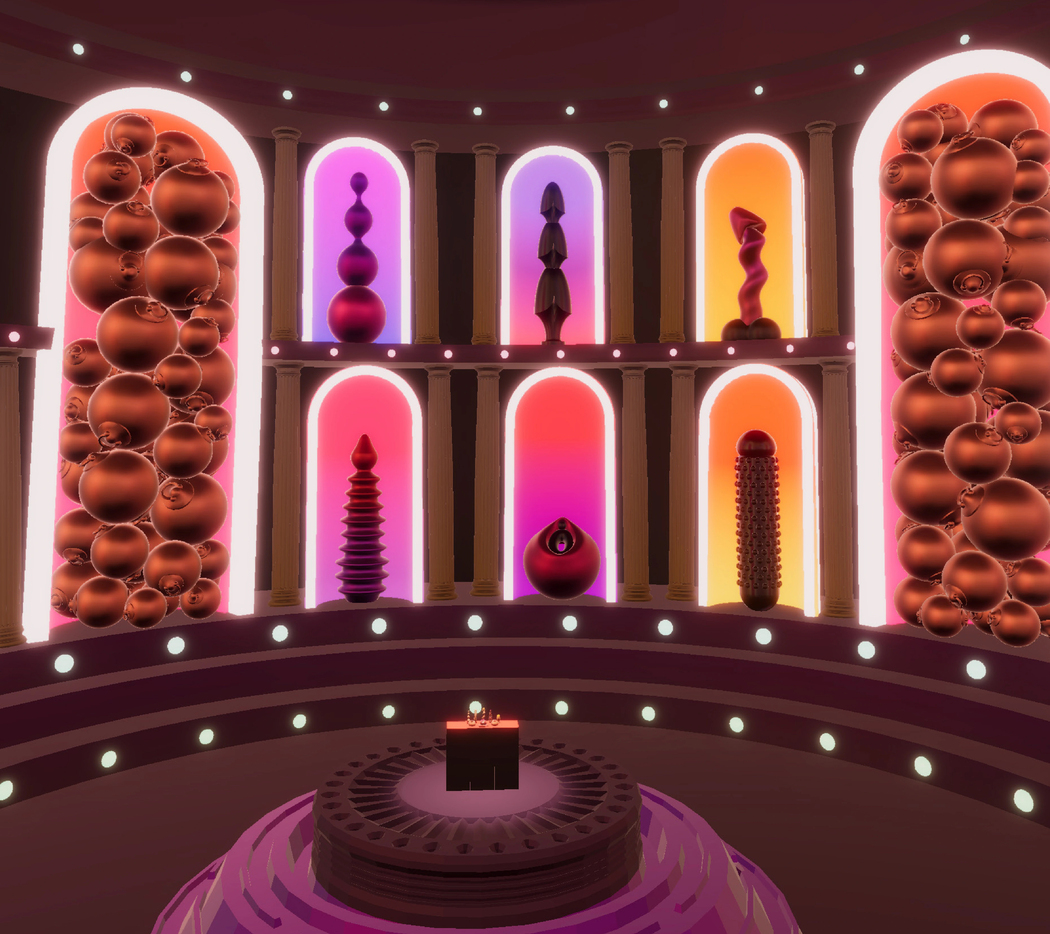Seyyed Mostafa Seyyed Ebrahimi
Mostafa Seyyedebrahimi’s art lives in the tension between the hand-made and the digitally born, fusing traditional craft with virtual worlds in ways that feel both exploratory and meticulously planned. He dives headfirst into weighty subject matter—death, ecological collapse, sexuality, religious orthodoxy—yet never resorts to didacticism or emotional distance. Instead, he peppers these heavy topics with surprising flashes of genuine touch, quiet reflection, and sly humor that give viewers room to breathe.
His XR installations carry a rare intensity: they brim with concept and purpose to the point where you sense him reaching for depth in every corner. That ambition can be almost dizzying, but it’s also what makes the work so unforgettable. A gentle flood of sensory detail becomes part of the narrative itself, and by the time you lift your headset, you’re not just thinking—you’re feeling differently. What sticks isn’t just the ideas, but the visceral memory of having inhabited them.
Anna Gvozdeva (curator)
Year of birth: 1989.
Where I live: United Kingdom.
Education: BA Graphic Design, MA Virtual reality.
Discipline: Immersive Art and XR Storytelling.
Website
Your artistic journey began with an upbringing in a deeply restrictive religious environment. How do you feel this background has shaped the themes and methods you explore in your art today?
I grew up in a home where every book, every conversation, and every question felt subject to unseen boundaries. When voices are kept low, you get very good at hearing whispers in the silence. Those early rules made me sensitive to anything unsaid or edited out, and that’s exactly where my work lives now. I chase the stories left in the margins: desires called “sinful,” emotions that were never given air. I’m not interested in shock for shock’s sake; I’m interested in truth that’s been stuffed into cupboards. Making art became a way to pull it back into daylight—for myself and for anyone else whose story got folded away under “proper” and “appropriate.”
“Ooh, La La!” challenges societal norms surrounding sexuality by exploring the concept of a “sextoys” through humor and symbolism. Can you talk about how humor plays a role in your work and why you chose to combine it with such a charged subject matter?
Humor is my favorite crowbar. The minute you laugh, your guard drops a few inches and suddenly the subject—sex toys, in this case—isn’t frightening; it’s playful, even musical. In Ooh, La La! the toys double as instruments in a Mixed-Reality orchestra. You’re busy banging out a beat, then halfway through you realise you’re also dismantling a lifetime of taboo. The joke isn’t there to cheapen the topic; it’s there to soften the walls so we can talk about intimacy without the usual blush or shame. I lean on the same logic Mark Twain celebrated: “Against the assault of laughter, nothing can stand.” Once people drop their weapons, real conversation can start.

You mention creating art that invites people to question their assumptions. How do you balance provoking thought with ensuring that the audience can engage with the work without feeling alienated?
Every artwork I create has layers: an open window for casual curiosity, a secret corridor for the daring, and a full-immersion gateway for those prepared to surrender to what I have created. In Ooh, La La, one can appreciate the surface with a quick laugh and a pleasant beat; nonetheless, the mixed-reality orchestra pushes everyone ready towards a fun re-evaluation of intimacy. The illustrated book in Etidorhpa seems familiar, yet eye-tracking VR gently transports viewers to worlds they have never ventured into. While keeping the story thread obvious, I can broaden the audience’s perspective without breaking the link that would inspire them to stay by letting them gently deep to go.
How do you approach blending traditional techniques with contemporary technology in your work? Can you share an example?
I learned art with a pencil in my hand and oil paint under my fingernails, yet loving and doing it. Later, curiosity dragged me into 3D animation and immersive art, and that opened the tech door wide. Indeed, I just added more toys to my toolbox.
What excites me about new-media art is the way it stretches a viewer’s attention span. A framed painting might earn ten seconds before someone drifts on, but step into a headset and you’re suddenly breathing the artwork and living inside it. Interactive media gives me levers that traditional surfaces can’t. I can hide a charcoal drawing inside a digital corridor, let a soundtrack respond to your footsteps, or make the light change when you tilt your head. Those small interactions stack up and keep people exploring far longer than they’d usually stand in front of a canvas.
Take The Other Side of Death. I scanned my pen-and-charcoal drawings and textures so the grit and smear survive in VR; nothing feels computer-slick. In one scene I borrowed Escher’s House of Stairs lithograph—essentially a 360-degree illustration before 360 even existed. I wrapped that drawing into a spherical environment, so you can immerse yourself in his paradox instead of just staring at it. Escher did the mind-bending math on paper; VR finally lets us walk inside it. That’s the sweet spot for me: honoring the hand-made while using technology to turn a quick glance into a full-body conversation.
Your work spans different mediums and technologies, from pencil sketches to virtual reality. How do you choose which medium best suits each project?
I don’t start by picking a tool; I start by exploring the idea. As I sketch, I ask whether the piece needs stillness or movement—observation or immersion. If it wants an intimate, frozen moment, I lean into traditional printmaking or drawing. Stolen Life, for instance, became a calcography print because the story needed the hush of a still-life: viewers pause, study the etched lines, and sit with the quiet tension. If the concept keeps nudging me toward immersion and interaction—sound that reacts, space that unfolds—then I push it into VR or mixed reality. So the medium isn’t a preset choice; it’s a discovery that happens mid-exploration, guided by whatever form best amplifies the work’s heartbeat.
“Ooh, La La!” transforms the term “sex toy” into something playful and familiar. Is there a fine line between subverting taboo topics and potentially reinforcing them?
Absolutely—and I feel that knife-edge every time I install the piece. Subversion can tip into mockery or even reinforce the old stigma if the framing is off. So I start with two checkpoints: intent and context. Intent: Am I lifting shame off the object or just re-packaging it? Every element—from the candy-coloured palette to the musical “instruments”—is designed to signal play rather than embarrassment. Context: The laughter isn’t aimed at the participants—it’s shared with them, and the joke is really on the cultural baggage we all carry.
The audience response tells me if I’ve stayed on the right side of that line. At all of my showcases several visitors admitted they’d hovered at the doorway, cheeks warming, because “sex toy” set off every alarm. Five minutes later they were drumming on the virtual toys, giggling, and waving friends or partners over: “Come on, it’s not what you think—get in here!”.
Those reactions—initial blush turning into open invitation—are the metric I watch. If people leave feeling lighter and curious rather than judged or objectified, the subversion has done its job without sliding into the very shame it tries to dismantle

Can you share a moment when you realised immersive art—like VR—could amplify your ideas and deepen audience connection?
There have been a couple “this is it” moments, but Etidorhpa sealed the deal. The work puts you in a hallway surrounded by stacked, mouthless heads. One time I watched a visitor bite her lip and hunch her shoulders, sliding sideways so the heads wouldn’t brush her. When she finally pulled off the headset she said, “I was inside your head for all the time.” That told me VR had reached her nervous system before her intellect could catch up.
Also, I noticed others reaching instinctively for the glowing particles in the last scene—hands outstretched like children trying to catch fireflies—then keeping them there because the particles react. Fear, wonder, play: all firing at once. Those reactions made it clear that immersive art can slip past the usual mental filters and go straight to heartbeat and breath. Once you connect with an audience at that level, there’s no going back to flat surfaces alone.



Leave a Reply